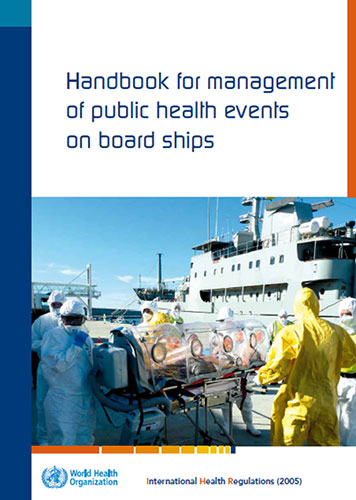Сб с 10 до 16
Handbook for management of public health events on board ships/Пособие по организации общественных мероприятий по здравоохранению на судах
Издание на английском языке
With the adoption of the International Health Regulations (IHR) by the World Health Assembly in May 2005, States Parties agreed to develop, strengthen and maintain public health core capacities related to surveillance and response at designated points of entry (PoE) as specified in IHR Annex 1. Furthermore, States Parties agreed to establish and maintain public health emergency contingency plans at PoE to prevent the spread of diseases internationally. IHR assigns the World Health Organization (WHO) the responsibility to publish, in consultation with States Parties, guidelines on the development of public health response capacities. To assist States Parties in contingency planning and implementation of health measures on board ships or in ports, WHO developed a generic guidance addressing all public health risks and related rules and regulations.
According to IHR, competent authorities at ports are responsible for responding to events that pose a risk to public health. These events are identified through notifications by ships or other competent authorities, during a ship inspection or even through other informal routes such as media reports. Events may be caused by biological, chemical or radiological agents. Event management involves event identification, verification, risk assessment and response.
The development of this document was launched in 2011. While initially conceived as a concise technical document, it has evolved into a comprehensive text that draws on the scientific literature and lessons learned from recent disease outbreaks to provide substantive public health guidance. Considerable efforts have been made to consult with stakeholders through opportunities for input and feedback in 2011, 2012 and 2014, which has led to contributions to this document by public health and shipping sector stakeholders.
In the time since this guidance has been written, the global community has experienced two outbreaks. The first of which, the Ebola virus disease (EVD), was declared a “public health emergency of international concern” by the IHR Emergency Committee in August 2014. At this writing, the second outbreak, Middle East respiratory syndrome coronavirus (MERS-CoV) continues to cause infection in various Member States and regions of the world. The lessons learned from the global response to these outbreaks, particularly in relation to public health measures adopted at PoE, have been incorporated into this guidance, either as direct references or through links to relevant documents. It is anticipated that this guidance document will continue to reflect best practices in the management of public health events in shipping transport through future reviews and revisions.
Contents
Executive summary
Acknowledgements
WHO contributors
Acronyms
Definitions
1. Introduction
1.1 Background
1.2 Purpose and scope
1.3 Methodology
2. Legal framework
3. Communication
3.1 Essential arrangements for communication available at all times
3.2 Communication from port to national level
3.3 Communication between ports
3.4 Communication with media
4. Event detection
5 Preliminary standard response at the port
5.1 Event verification
5.2 Ascertaining immediate arrangements – preliminary assessment and reporting
6. Event risk assessment at the port level
6.1 Risk assessment procedure at the port level
6.2 Assessment on board the ship
6.3 Update of assessment
6.4 Risks at the port environment or during the activities of travellers while ashore
7 Response measures
7.1 Roles and responsibilities
7.2 Events where the competent authority should consider taking action
7.3 Response measures to events of infectious diseases
7.4 Health measures for selected situations of an infectious nature
7.5 Response measures to events related to risks in the environment
7.6 Response measures to events of unknown etiology including chemical and radiological hazards
7.7 Additional health measures that significantly interfere with international traffic
7.8 Safeguard measures of personnel involved in event management
8. Options for health measures
8.1 Public health measures with respect to persons
8.2 Public health measures with respect to ships and inanimate objects
8.3 Use of specific health measures to ensure the safe handling and transport of human remains
8.4 Public health measures for affected animals
References
Annex 1. Events of infectious diseases linked with ships based on a literature review
Annex 2. Disease-specific measures
Annex 3. Event management flowchart
Annex 4. Guidance on establishing public health assessment interview spaces




